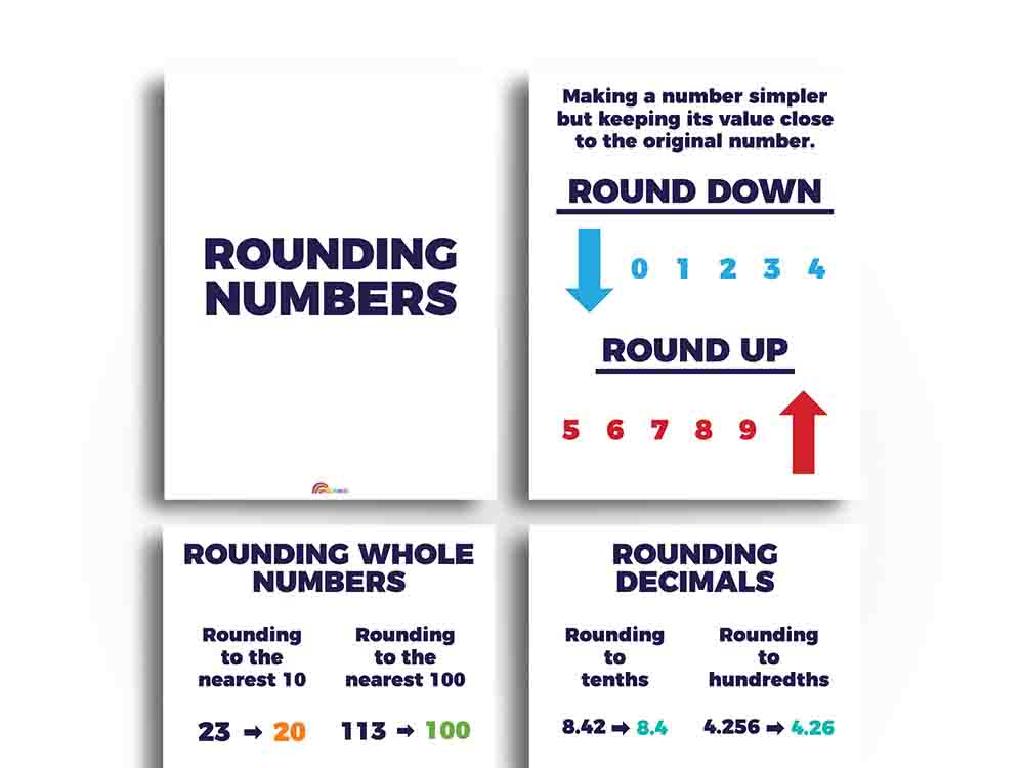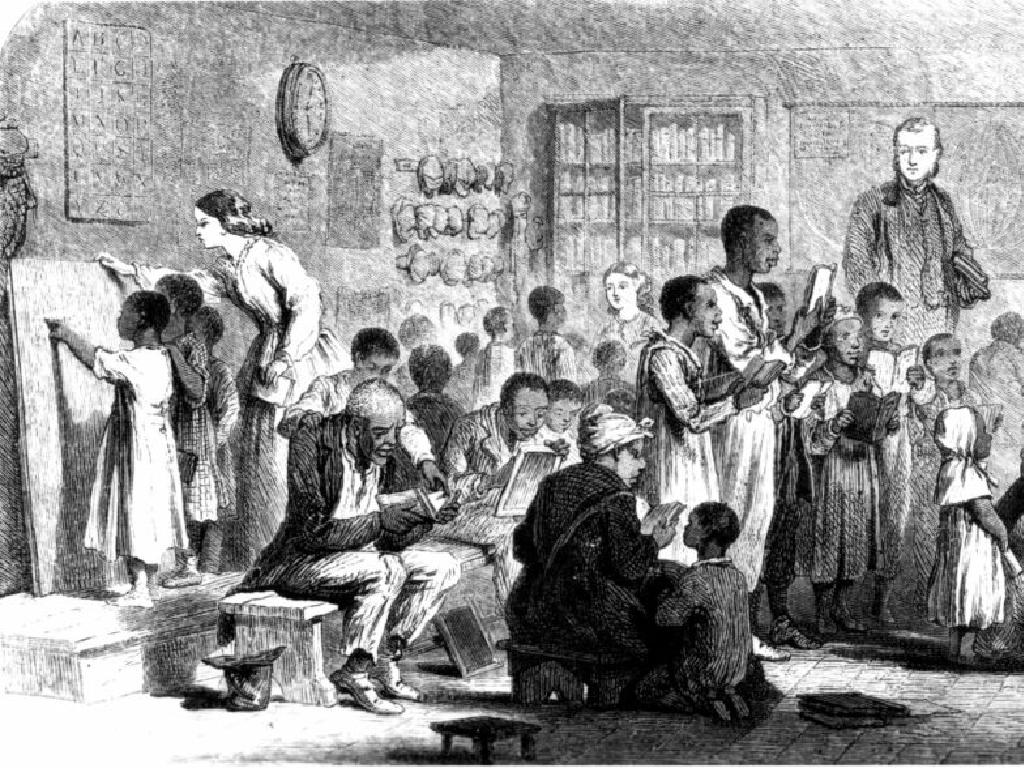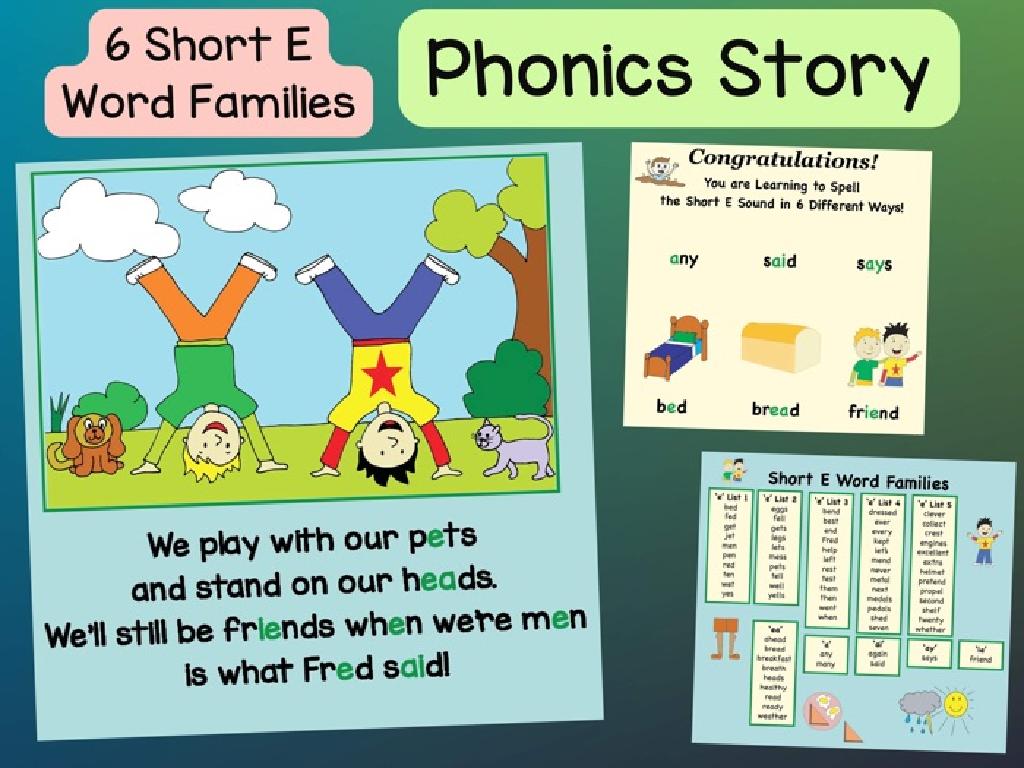Division Facts For 6, 7, 8, And 9: Sorting
Subject: Math
Grade: Third grade
Topic: Division Fluency Up To 10
Please LOG IN to download the presentation. Access is available to registered users only.
View More Content
Today’s Adventure: Division Facts for 6, 7, 8, and 9!
– Learn to share equally
– Division means splitting into equal parts or groups.
– Division facts for 6, 7, 8, 9
– We’ll explore how to divide numbers by 6, 7, 8, and 9.
– Why division matters
– It helps us in daily life, like sharing snacks fairly!
– Practice makes perfect
– The more we practice, the quicker we’ll solve problems.
|
Welcome students to the world of division, emphasizing the concept of sharing things equally. Introduce division facts for 6, 7, 8, and 9, ensuring students understand that division is about evenly distributing items into groups. Explain the practical importance of division in everyday situations, such as dividing up treats or toys among friends. Encourage students to see division as a useful tool rather than a challenge. Provide plenty of practice opportunities with different numbers to help students become fluent in division facts for these numbers. Remember to praise effort and improvement to build confidence.
Understanding Division
– Division is sharing equally
– Imagine splitting cookies evenly with friends
– It shows how many groups we can make
– If we have 12 cookies, how many groups of 4 can we make?
– It tells us items per group when sharing
– With 18 cookies, how many cookies does each friend get if we make 6 groups?
– Practice with division facts for 6, 7, 8, 9
|
This slide introduces the concept of division to third graders by relating it to the familiar activity of sharing cookies equally among friends. Explain that division can be used to find out how many equal groups can be made from a number of items, or how many items will be in each group. Use real-life examples like sharing snacks to make the concept relatable. Encourage students to think of division as a fair way to distribute items. After explaining the concept, move on to practicing division facts for 6, 7, 8, and 9, using examples and visual aids like counters or drawings to help them understand. Prepare to have students work on simple division problems in groups or individually to reinforce the concept.
Division Facts for 6: Sharing Apples
– Dividing 6 apples among friends
– Imagine 6 apples to share with 3 friends
– Each friend gets an equal share
– 6 divided by 3 equals?
– Each friend gets 2 apples!
– Understanding division with 6
– Division shows us how to share equally
|
This slide introduces the concept of division by using a relatable example of sharing apples among friends. Start by asking students to visualize 6 apples and think about how they would share them equally among 3 friends. This helps them understand that division is essentially dividing a number into equal parts. After explaining the concept, confirm their understanding by asking how many apples each friend gets when 6 apples are divided by 3. Reinforce the idea that division is fair sharing and that 6 divided by 3 results in 2 apples per friend. Encourage students to come up with similar examples and practice dividing different numbers of items by 6.
Division Facts for 7: Grouping Stars
– Visualize 7 stars, 7 groups
– Picture 7 stars in the sky, make 7 groups
– Each group gets 1 star
– Dividing 14 stars into 7 groups
– How many stars in each of the 7 groups?
– Understanding division with stars
– Use stars to make division clear and fun
|
This slide is aimed at helping third-grade students understand division by using visualization and real-world examples. Start by asking students to imagine 7 stars in the sky and to visualize grouping these stars into 7 different groups. This will help them see that when we divide 7 stars by 7 groups, each group has 1 star, so 7 divided by 7 equals 1. Then, challenge them by doubling the number of stars to 14 and asking how we can divide these into 7 groups. This exercise will reinforce the concept of division as making equal groups and will prepare them for understanding that 14 divided by 7 equals 2. Encourage students to draw this out or use physical objects like counters to represent the stars for a hands-on experience.
Division Facts for 8: Sharing Equally
– Understanding division with 8 wheels
– If we have 8 wheels and want to make 4 cars, how many wheels does each car get?
– Each car gets 2 wheels from 8
– 8 wheels divided by 4 cars equals 2 wheels per car
– Dividing 8 cookies between 2 friends
– Imagine you have 8 cookies to share with a friend, how many cookies does each person get?
– Practice dividing 8 into equal parts
|
This slide is designed to help students understand the concept of division by using relatable examples. Start by discussing the scenario of having 8 wheels to distribute equally among 4 cars, which illustrates that each car would receive 2 wheels. This demonstrates that 8 divided by 4 equals 2. Then, transition to a more relatable example for the students: dividing 8 cookies between 2 friends. This will help them visualize the division process and understand that each friend would get 4 cookies. Encourage the students to think of other examples where they might divide 8 into equal parts, and ask them to share their ideas. This interactive approach helps solidify their understanding of division facts for the number 8.
Division Facts for 9: Sharing Treasure
– 9 pirates share 9 coins equally
– Each pirate gets 1 coin: 9 ÷ 9 = 1
– Share 9 coins among 3 pirates
– Each pirate gets 3 coins: 9 ÷ 3 = 3
|
This slide is designed to help students understand division through a relatable and engaging story about pirates sharing treasure. Start by setting the scene with 9 pirates who have found 9 gold coins. Ask the students how the pirates can share the coins equally. This leads to the understanding that when a number is divided by itself, the result is always 1. Then, introduce a scenario where the 9 coins are shared among 3 pirates, which helps students see that 9 divided by 3 equals 3. Use physical coins or visual aids to demonstrate the division if possible. Encourage the students to come up with similar division stories and share them with the class. This activity will reinforce the concept of equal sharing as division and provide a foundation for understanding division facts for 9.
Sorting Division Facts
– Sort by the divisor
– Divisor is the number you divide by
– Create groups for 6, 7, 8, 9
– Put division facts into 4 separate groups
– Easier recall of facts
– Sorting helps memorize division facts
– Practice with examples
– Use examples like 18 ÷ 6, 49 ÷ 7 to practice
|
This slide is aimed at helping third-grade students understand and memorize division facts for the numbers 6, 7, 8, and 9 by sorting them into groups. By categorizing the division facts based on the divisor, students can more easily recall the correct answers. For example, all division facts that involve dividing by 6 should be in one group. This visual and organizational strategy can aid in enhancing their division fluency. During the lesson, provide students with several examples and encourage them to create their own sorted lists of division facts. As an activity, they can work in groups to sort a mixed set of division facts and then share their sorted lists with the class.
Practice Time: Division with Objects
– Solve division problems together
– Use objects for visual aid
– Fruits, stars, wheels, coins to represent numbers
– Share equally among groups
– If we have 8 wheels, how many cars can we make?
– Count each group carefully
– Ensure each group has the same number of items
|
This slide is designed to engage students in a hands-on division activity. By using tangible objects like fruits or coins, students can visually comprehend the concept of division as sharing equally. Encourage students to group the objects and count them to solve division problems. For example, if there are 8 wheels, ask how many cars can be made if each car needs 4 wheels, leading to the answer 2. This activity helps reinforce the division facts for 6, 7, 8, and 9 by providing a concrete understanding of how division works. Make sure to walk around the classroom to assist students who may struggle and to confirm that each group has an equal number of items. Prepare additional examples for students who finish early or need extra practice.
Class Activity: Division Bingo Fun!
– Play Division Bingo with new facts
– Solve and cover the answer on your card
– Use division facts for 6, 7, 8, and 9 to find answers
– Aim to cover a full row first
– Shout ‘Bingo!’ when you do
– We’ll verify the answers together as a class
|
This interactive class activity is designed to help students practice and reinforce their understanding of division facts for 6, 7, 8, and 9. Prepare Bingo cards in advance, with answers to division facts up to 10 randomly placed on each card. During the activity, call out division problems (e.g., 42 ÷ 7) and have students solve them and cover the correct answers on their Bingo cards. The first student to cover a full row (horizontal, vertical, or diagonal) should shout ‘Bingo!’ and stand up. Pause the game to check their answers together, ensuring they’ve correctly solved the division facts. This game encourages quick thinking and offers a fun way to assess students’ fluency with division. Have small prizes or stickers for winners to make the game more exciting. If time allows, play multiple rounds to give all students a chance to win.
Division Stars: Wrapping Up!
– Mastery of division facts for 6, 7, 8, 9
– Continue practicing to perfect skills
– Try daily practice with flashcards or apps
– Recognizing your hard work and progress
– Keep shining as division stars at home!
– Share your division victories with family
|
Congratulations to the class for learning the division facts for 6, 7, 8, and 9. Emphasize the importance of continued practice to solidify these skills, suggesting methods such as flashcards, educational apps, or simple daily exercises. Acknowledge the effort and progress made by the students, reinforcing their confidence in their abilities. Encourage them to continue practicing at home and to involve their families in their learning journey by sharing their successes. This positive reinforcement will help motivate them to keep improving their division fluency.





